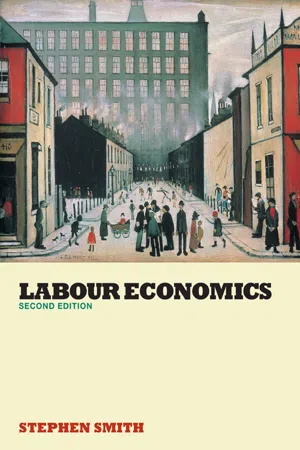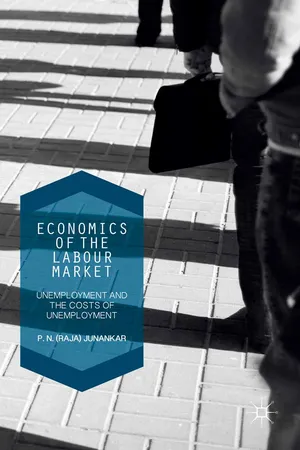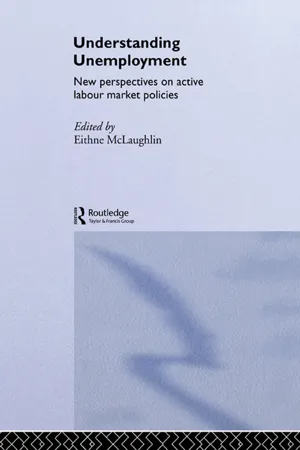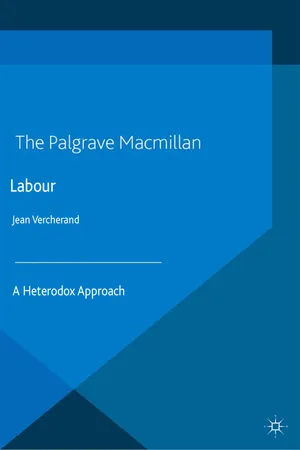Economics
Supply for Labour
Supply for labor refers to the quantity of labor that individuals are willing and able to offer for employment at various wage rates. It is influenced by factors such as wage levels, non-monetary benefits, and the availability of alternative job opportunities. As wages increase, the supply of labor typically increases as individuals are incentivized to work more.
Written by Perlego with AI-assistance
Related key terms
5 Key excerpts on "Supply for Labour"
- eBook - ePub
- Stephen W. Smith(Author)
- 2003(Publication Date)
- Routledge(Publisher)
1 Labour supply INTRODUCTIONCurrently labour supply is one of the most active research areas in labour economics. According to Blundell and MaCurdy (1999) ‘research on labour supply during the past decade has been at the forefront of developments in empirical microeconomics’ (p. 1560). The surveys by Killingsworth (1983), Pencavel (1986) and Heckman (1993) bear witness to this activity at both the theoretical and empirical levels. It is not our intention either to replicate or to replace such near-exhaustive treatments. Instead this chapter will outline the dominant neoclassical theory of labour supply before extending the analysis to examine the effects of varying wage rates, incorporate income taxation, and introduce non-work welfare benefits. We shall distinguish between male and female labour supply both in theory and empirically. The more dynamic lifecycle modelling of labour supply will also be considered. There are important topical policy aspects of labour supply that need to be addressed, ranging across: concern over demographic changes; discussion about the role of women in the paid labour market; and consideration of the impacts of the tax and welfare benefit regimes. Our analysis of labour supply will touch upon all of these policy issues. It will also lay the foundation for the subsequent treatment of the other areas of labour economics, in particular, job search (Chapter 9 ), education, training and employee signalling (Chapter 5 ) and the supply-side view of unemployment (Chapter 10 ). An understanding of labour supply will also enter into an assessment of movements in labour productivity through an examination of labour supply responses to varying wage rates, a link that will be made explicit in Chapter 3 .INDIVIDUAL LABOUR SUPPLYThe supply of labour can be analysed at two levels: the microeconomic level, concerned with individual and household labour supply, and the macroeconomic or aggregate economy level. The following account of the economic analysis of labour supply begins with a microeconomic theory based upon the neoclassical solution to the consumers’ allocation problem. - eBook - ePub
Economics of the Labour Market
Unemployment, Long-Term Unemployment and the Costs of Unemployment
- P. N. (Raja) Junankar, P. N. (Raja) Junankar(Authors)
- 2016(Publication Date)
- Palgrave Macmillan(Publisher)
Handbook of Labor Economics , Vol. 1, eds. Orley C. Ashenfelter and Richard Layard. Amsterdam: North Holland.Lazear, Edward P. 1995. Personnel Economics . Cambridge, MA: MIT Press.Lewis, W. Arthur 1954. Economic Development with Unlimited Supplies of Labour. Manchester School of Economic and Social Studies 22: 139–192.Lucas, Robert E., Jr., and Leonard A. Rapping. 1969. Real Wages, Employment, and Inflation. Journal of Political Economy 77 (5): 721–754.Mortensen, Dale T., and Christopher A. Pissarides. 1999. New Developments in Models of Search in the Labor Market. In Handbook of Labor Economics , Vol. 3, eds. Orley C. Ashenfelter and David Card. Amsterdam: North Holland.Neumark, David, and William Wascher. 1992. Employment Effects of Minimum and Subminimum Wages. Industrial and Labor Relations Review 46 (1): 55–81.Pencavel, John 1986. Labor Supply of Men. In Handbook of Labor Economics , Vol. 1, eds. Orley C. Ashenfelter and Richard Layard. 1986. Amsterdam: North Holland.Senesky, Sarah. 2005. Testing the Intertemporal Labor Supply Model: Are Jobs Important? Labour Economics 12 (6): 749–772.Vermeulen, Frederic. 2002. Collective Household Models: Principles and Main Results. Journal of Economic Surveys . 16 (4): 533–564.Reprinted from ‘Labor Supply’ by P. N. Junankar in International Encyclopedia of the Social Sciences , 2nd edition. 9 vols, edited by William A. Darity Jr. Detroit: Macmillan Reference USA, 2008. With kind permission from Macmillan Publishers Ltd. All rights reserved.Passage contains an image
2.4
Labor Force Participation
P. N. JunankarThe labor force participation rate is defined as the proportion of a population that is either employed for pay or profit (for one hour or more in the reference week or fortnight) or looking for paid work over some period of time. By definition, people who are carrying out unpaid work in the home or voluntary work are not counted as employed. - eBook - ePub
Understanding Unemployment
New Perspectives on Active Labour Market Policies
- Eithne Mclaughlin(Author)
- 2013(Publication Date)
- Routledge(Publisher)
White and McRae 1989 ). One of the reasons for giving attention to labour quality is that improved labour supply may provide a way of outflanking the impasse of wage rigidity.Labour quality has considerable importance, over and above its influence on wage fixing, for international economic competitiveness. Appreciation of this has grown during the past decade (Hayes and Fonda 1984 ; OECD 1989a) so that the assertion no longer seems controversial. To compete with other advanced industrial countries, an economy needs considerable powers of innovation, in services as well as in products, and the ability to provide high standards of quality. These competitive characteristics can best be achieved through investment in human resources.Perhaps the most important reason for emphasizing the quality dimension of labour supply is its bearing on equity for individuals. Without an adequate preparation in terms of education and training, individuals will be placed at a disadvantage in relation to both opportunities and to economic hazards during their working lives (see Chapter 4 ).The demand for labour quality
Demand for different sorts of labour over the next decade can be assessed partly by extrapolating the established trends and partly by considering the major developments likely to be continuing or taking place over the period. The trends are clear, although it must be emphasized that these represent the interaction of supply and demand rather than demand as such. The 1989 Labour Force Survey (Employment Gazette, 1990a) shows that nearly four-fifths of the employment growth in 1984–9 was attributable to non-manual occupations, and about one-half to what may loosely be called ‘higher’ occupations. The manual occupations accounted for a little over one-fifth of total employment growth; but most of that growth came in 1988–9 (see Figure 2.2 - eBook - ePub
- Martin Prachowny(Author)
- 2012(Publication Date)
- Routledge(Publisher)
hours, positions on the labor-supply curve are superior in a welfare sense to those positions off the curve. To the left of the supply curve at any given real wage, there are a number of people who want to work but are not employed and are therefore involuntarily unemployed. On the other hand, a position to the right of the supply curve would require involuntary exchange.- The supply of labor is composed of heterogeneous individuals, even though the participation decision has been derived from a utility-maximizing “representative agent”. Remembering that the supply curve is generated by having more and more people pass their reservation wage, those with very low reservation wages and early entry into the labor market enjoy rents at any wage above their reservation wage. These people earn rents because their welfare rises with the real wage but without any adjustment of their behavior. Hence, it is possible to order sequentially all individuals in the labor market by the amount of rent they receive from employment; those with the lowest reservation wage receive the largest rents.
3.2 The Demand for LaborWhile supply decisions in the labor market are made by individual worker-consumers, demand decisions are made by firms and their management. The major choice made by a productive enterprise is the input-output relationship: given a certain goal for output over a specific time frame, what factors of production should the firm use and how much of each? The ultimate aim of the firm is to maximize its profits, which represents the difference between its revenue generated by sales of output and costs dictated by payments to its factors of production.3.2.1Profit-maximizing Choices for a Firm's InputsThis maximization process can be written as:where II are profits in real terms (i.e., adjusted for price changes), Y( ) is the production function for output, a composite commodity for the entire economy, NH stands for the total hours worked by the firm's labor force and K represents the capital stock used in the production process. Consistent with the assumption made in the discussion of labor supply, each person works H hours per day for W/P per hour in real terms or H W/P per day. Capital, on the other hand, is a stock of equipment and structures such as machinery, warehouses and computers, available to the firm, for which it pays a user cost per unit of time, R/P, as if it were leasing its capital from a firm specializing in this function. Some of the properties of the production function are: (a) marginal products of each factor are positive, (b) marginal products decline as more of the factor is used, and (c) marginal products increase when more of the co-operating factor is available, - eBook - ePub
Labour
A Heterodox Approach
- Jean Vercherand(Author)
- 2014(Publication Date)
- Palgrave Macmillan(Publisher)
perfectly free and of independent will .Figure 2.1 The basic neoclassical representation of the labour marketIn this basic model, labour is considered perfectly homogeneous: all workers have the same productivity. This simplification will be conserved throughout this book, except for a few indicated exceptions.Let us examine successively how this global supply and demand for labour is determined. 1 The theory of labour supply 1.1 The hypothesis of optimal choice 1.1.1 The equalisation of the marginal utility and disutility of labourIndividual supply, that is to say, the number of hours of work that a household is ready to supply for a given wage rate, corresponds to the optimised use of its time. It will work until the marginal utility of its labour tends to be exceeded by its marginal disutility, meaning that until the utility, in terms of income and other rewards, of an extra hour of work becomes lower than its cost in terms of additional fatigue, rest and missed leisure time (see Figure 2.2 ).Intuitively, it becomes obvious that the first hours of work are of great use for a household, especially if they have no income other than that earned from work, since they allow it to satisfy its most pressing needs. However, as the hours of work increase and the most vital needs are satisfied (by the income acquired), the additional utility of each new hour of work decreases. Simultaneously, as the work time accumulates, the greater the disutility – the cost – of each additional hour. A rational household will continue to work as long as the additional utility of each hour of work remains higher than its disutility, and when parity is reached, it will stop working. That being said, these functions of utility and disutility are influenced by a large number of parameters. In particular, that of work depends on the rate of remuneration, the non-monetary satisfaction that the work may provide, the utility of the income itself in terms of additional goods and the additional savings that can be acquired (and thus the assets already owned). The function of disutility depends on its difficulty and the opportunity cost of the utility of the free time sacrificed (and thus the existing chances of profiting from leisure time).
Index pages curate the most relevant extracts from our library of academic textbooks. They’ve been created using an in-house natural language model (NLM), each adding context and meaning to key research topics.




